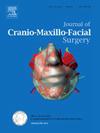颞下颌关节镜下进入上关节间隙距离的三维断层成像评估。
IF 2.1
2区 医学
Q2 DENTISTRY, ORAL SURGERY & MEDICINE
引用次数: 0
摘要
近年来,关节内病变的微创手术治疗技术的改进和推广在治疗领域获得了相当大的相关性,主要是由于与此类干预相关的发病率降低。尽管有这些优点,关节镜手术并非没有风险,特别是因为套管针和器械插入关节时经常以盲目的方式进行,从而增加了意外医源性事件和技术并发症的可能性。鉴于这些局限性,本研究试图进行基于计算机断层扫描的三维形态分析,以确定关节镜干预期间关节内通路的精确解剖参数。为此,共分析了50张计算机断层扫描(CT),目的是计算关节镜内固定的三维插入点。随后将这些值与文献中先前建立的线性参考测量值进行比较,并在性别之间和按肥胖状况分层的个体之间进行比较。结果显示,与先前研究中报道的标准解剖学参考文献相比,差异很小,在男性和女性个体之间没有统计学上的显著差异。然而,肥胖和非肥胖受试者之间存在显著差异,特别是在访问部位上的软组织厚度方面。这些发现强调了肥胖患者个体关节镜入路计划的必要性,以考虑这种解剖差异,从而降低入路相关并发症的风险并提高手术安全性。本文章由计算机程序翻译,如有差异,请以英文原文为准。
Three-dimensional tomographic assessment of the distances for access to superior joint space in the arthroscopy of temporomandibular joint
In recent years, the refinement and dissemination of minimally invasive techniques for the surgical management of intra-articular pathologies have gained considerable relevance within the therapeutic arsenal, chiefly owing to the reduced morbidity associated with such interventions. Despite these advantages, arthroscopic procedures are not devoid of risks, particularly because the insertion of trocars and instruments into the joint is frequently performed in a blind manner, thereby increasing the likelihood of inadvertent iatrogenic events and technical complications. In view of these limitations, the present investigation sought to undertake a tridimensional morphometric analysis based on computed tomography in order to define precise anatomical parameters for intra-articular access routes during arthroscopic interventions. For this purpose, a total of 50 computed tomography (CT) scans were analyzed, with the goal of calculating three-dimensional insertion points for arthroscopic instrumentation. These values were subsequently compared with linear reference measurements previously established in the literature, as well as between gender and across individuals stratified by obesity status. The results demonstrated minimal variation in relation to the standard anatomical references reported in prior studies, with no statistically significant differences detected between male and female individuals. However, a significant disparity was identified between obese and non-obese subjects, particularly with respect to the soft tissue thickness overlying the access site. These findings underscore the necessity of individual arthroscopic entry point planning in obese patients to account for such anatomical differences, thereby reducing the risk of access-related complications and enhancing procedural safety.
求助全文
通过发布文献求助,成功后即可免费获取论文全文。
去求助
来源期刊
CiteScore
5.20
自引率
22.60%
发文量
117
审稿时长
70 days
期刊介绍:
The Journal of Cranio-Maxillofacial Surgery publishes articles covering all aspects of surgery of the head, face and jaw. Specific topics covered recently have included:
• Distraction osteogenesis
• Synthetic bone substitutes
• Fibroblast growth factors
• Fetal wound healing
• Skull base surgery
• Computer-assisted surgery
• Vascularized bone grafts

 求助内容:
求助内容: 应助结果提醒方式:
应助结果提醒方式:


